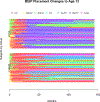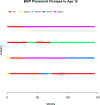The Impact of Caregiving Disruptions of Previously Institutionalized Children on Multiple Outcomes in Late Childhood
- PMID: 30295918
- PMCID: PMC7197095
- DOI: 10.1111/cdev.13169
The Impact of Caregiving Disruptions of Previously Institutionalized Children on Multiple Outcomes in Late Childhood
Abstract
This study examined disruptions in caregiving, as well as the association of these disruptions, with cognitive, behavioral, and social outcomes at age 12 in a sample of 136 Romanian children who were abandoned to institutions as infants and who experienced a range of subsequent types of care. Children were found to experience significantly more caregiving disruptions (CGD) earlier in life than later in childhood. More frequent CGD predicted increases in externalizing and internalizing behavior problems at age 12. Results are discussed in terms of the association between CGD and the long-term development of children who have experienced institutional rearing.
© 2018 Society for Research in Child Development.
Figures
References
-
- Barth RP, Lloyd C, Green RL, James S, Leslie LK, & Landsverk J (2007). Predictors of placement moves among children with and without emotional and behavioral disorders. Journal of Emotional and Behavioral Disorders, 14, 46–55. 10.1177/10634266070150010501 - DOI
-
- Bayley N (1993). Bayley Scales of Infant Development: Manual (2nd ed.). San Antonio, TX: Psychological Corporation.
-
- Boyce WT, Essex MJ, Goldstein LH, Armstrong JM, Kraemer HC, & Kupfer DJ (2002). The confluence of mental, physical, social, and academic difficulties in middle childhood. I: Exploring the “headwaters” of early life morbidities. Journal of the American Academy of Child & Adolescent Psychiatry, 41, 580–587. 10.1097/00004583-200205000-00016 - DOI - PubMed



